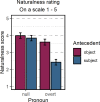Pronominal anaphora resolution in Polish: Investigating online sentence interpretation using eye-tracking
- PMID: 35015772
- PMCID: PMC8752000
- DOI: 10.1371/journal.pone.0262459
Pronominal anaphora resolution in Polish: Investigating online sentence interpretation using eye-tracking
Erratum in
-
Correction: Pronominal anaphora resolution in Polish: Investigating online sentence interpretation using eye-tracking.PLoS One. 2024 Jan 2;19(1):e0296557. doi: 10.1371/journal.pone.0296557. eCollection 2024. PLoS One. 2024. PMID: 38165895 Free PMC article.
Abstract
The mechanism of anaphora resolution is subject to large cross-linguistic differences. The most likely reason for this is the different sensitivity of pronouns to the range of factors that determine their reference. In the current study, we explored the mechanism of anaphora resolution in Polish. First, we explored preferences in the interpretation of null and overt pronouns in ambiguous sentences. More specifically, we investigated whether Polish speakers prefer to relate overt pronouns to subject or object antecedents. Subsequently, we tested the consequences of violating this bias when tracing the online sentence-interpretation process using eye-tracking. Our results show that Polish speakers have a strong preference for interpreting null pronouns as referring to subject antecedents and interpreting overt pronouns as referring to object antecedents. However, in online sentence interpretation, only overt pronouns showed sensitivity to a violation of the speaker's preference for a pronoun-antecedent match. This suggests that null pronoun resolution is more flexible than overt pronoun resolution. Our results indicate that it is much easier for Polish speakers to shift the reference of a null pronoun than an overt one whenever a pronoun is forced to refer to a less-preferred antecedent. These results are supported by naturalness ratings, which showed that null pronouns are considered equally natural regardless of their reference, while overt pronouns referring to subject antecedents are rated as considerably less natural than those referring to object antecedents. To explain this effect, we propose that the interpretation of null and overt pronouns is sensitive to different factors which determine their reference.
Conflict of interest statement
The authors have declared that no competing interests exist.
Figures






References
-
- Kaiser E, Trueswell JC. Interpreting pronouns and demonstratives in Finnish: Evidence for a form-specific approach to reference resolution. Lang Cogn Process. 2008. Aug;23(5):709–48.
-
- Sorace A, Filiaci F. Anaphora resolution in near-native speakers of Italian. Second Lang Res. 2006. Jul;22(3):339–68.
-
- Kwon N, Sturt P. Null pronominal (pro) resolution in Korean, a discourse-oriented language. Lang Cogn Process. 2013. Apr;28(3):377–87.
-
- Mazuka R. Processing of empty categories in Japanese. J Psycholinguist Res. 1991. May 1;20(3):215–32.
-
- Filiaci F, Sorace A, Carreiras M. Anaphoric biases of null and overt subjects in Italian and Spanish: a cross-linguistic comparison. Lang Cogn Neurosci. 2014. Aug 9;29(7):825–43.
Publication types
MeSH terms
LinkOut - more resources
Full Text Sources

